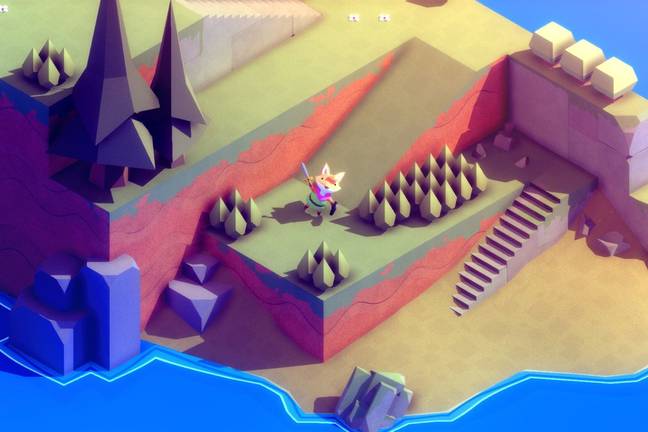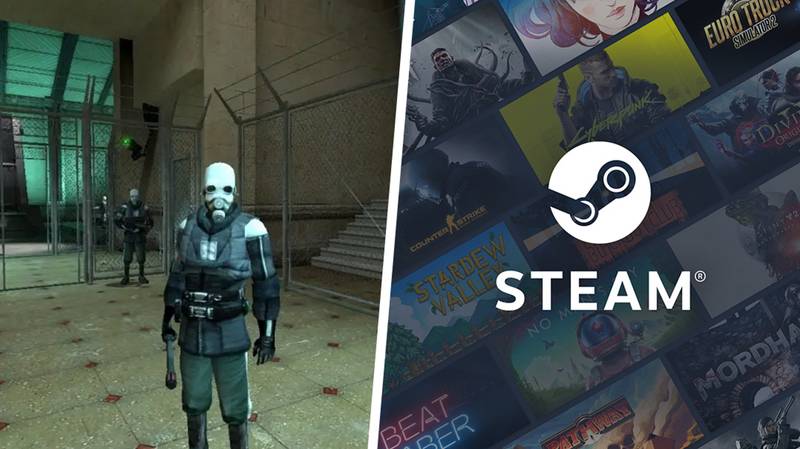‘Tunic’ Review: A Zelda-Inspired Puzzle Box Of Delights
Published
| Last updated

Featured Image Credit: Finji
TLC once famously advised us never to go chasing waterfalls. Fortunately, nobody ever bothered to relay this message to developer Andrew Shouldice.
His latest effort, Tunic, is a video game that knows you want to peek behind every cascading wall of water, swaying blade of grass, and crumbling statue in search of treasure. And it rewards that curiosity repeatedly, via an intricate puzzle box of a world filled with constant mystery, surprise, and revelation. It’s a truly astonishing piece of work that I can’t get out of my head.
Loading…
On the face of it, Tunic is a cute little Zelda-style game about a fox with a sword. A solid selling point, if ever there was one. There are environmental puzzles to solve, bosses to slay, and items to discover that will open up new areas. Its bright and colourful isometric style is a joy to behold, and evokes the feeling of peering inside a pop-up book as our furry friend braves grassy fields, toxic sewers, and mystical forests in search of adventure.
Look a little closer, however, and it soon becomes clear that Tunic is much more than another Zelda-lite. Its world has been ingeniously designed in such a way that there are a myriad of shortcuts, game-changing items, and crucial clues hiding in plain sight. I’d argue it’s more of a successor to 1986’s The Legend Of Zelda than any of the subsequent Zelda games.
On more than one occasion, I would emerge from a tomb or dungeon into the sunny overworld only to realise that the exit was tucked away behind a tree, or round the side of a pillar that I could have accessed at any point. One late-game area can be accessed almost immediately if you know where to look, but these routes are so well hidden that you’ll have no clue they were ever there until you’re coming out the other side. These secrets are literally everywhere, and stumbling across them is thrilling. Much like Outer Wilds or Dark Souls, Tunic is a game that can only be experienced in its purest form once. As soon as you learn how the world works, the game is irrevocably changed. This, of course, only serves to make that first playthrough all the more special.

Tunic’s world is vast and mysterious, filled with indecipherable text and items that come with little to no explanation. It’s a game purposefully designed to recall a time when the instruction manual was required reading, long before in-game tutorials would near-constantly remind players how to perform even the simplest actions.
Fortunately, Tunic does actually have a manual for those feeling stumped. Our smol fox chum can track down the scattered pages of it throughout the world, which can then be accessed and perused via the menu. This stunningly designed booklet is a real love letter to the original NES Zelda manual, complete with gorgeous art, hand-drawn maps, and various tips to get players started. If Finji wants to go ahead and recreate the whole thing IRL, I’d be first in line to buy one.
More than being nice to look at, the manual is also perhaps Tunic’s most crucial item. Pages will reveal integral clues, explain how to use gear, upgrade your skills, and guide you along the right path. There are even notes jotted down on its pages by the game’s previous owner for you to decipher, creating the impression that you’re simply the latest in a long line of players attempting to crack Tunic’s riddles. There were more than a few moments that Tunic had me sat cross-legged on the floor, scribbling down my own notes on a rough map I’d drawn out myself for reference. Without even realising it, the game had transported me back in time.
To see everything the game has to offer involves thorough inspection of every last inch of the manual, with the post-game’s final treasure hunt in particular forcing you to think so far outside of the box that the box becomes nothing more than a distant memory from a past life. It is, at times, maddeningly vague. But those eureka moments, when they come, are as satisfying as any gaming experience I’ve ever had.

Not everything in Tunic is quite as well implemented. The game requires a fair amount of backtracking - especially towards the end - and a relatively stingy fast-travel system makes this more of a slog than it needed to be.
Combat can be a little fiddly too, especially with larger crowds of enemies, thanks to a lock-on system that inexplicably snaps to random targets at the worst possible moments. Fortunately, there are a number of in-game options that allow players not interested in fighting to breeze through such encounters. The first allows for infinite stamina, giving players the choice to dodge and block as much as needed without fear of penalty. I found this to be a great middle ground for anyone looking to turn down the challenge just a shade. The second option is a pretty standard no-fail mode that allows you to run through enemies unbothered and focus on what Tunic does best: puzzle solving and staring at cute foxes.
Tunic is a lovingly made tribute to classic adventure games that still manages to offer its own clever twists on the well-established formula to create an inspired meta-game of interconnected puzzles hiding one larger conundrum. If you can resist the urge to check your phone for help whenever you get stuck, the joy of slowly cracking apart its intricate code is sublimely rewarding.
Much like Elden Ring, and Breath Of The Wild before it, Tunic offers yet more proof that there’s still a place for games that let go of our hands and allow us to figure things out for ourselves. Even as I write these words, several hours after rolling credits on the challenging and consistently surprising 10-hour adventure, I can’t help but wonder what secrets Tunic has left for me to discover.
Pros: Gorgeous storybook aesthetic, ingenious puzzles, expertly designed world, great options to toggle difficulty, I could look at the in-game manual forever
Cons: Occasionally clunky combat, annoying backtracking
For fans of: Dark Souls, The Legend Of Zelda, Death’s Door
9/10: Exceptional
Tunic is available now for Xbox Series X/S, Xbox One (version tested), and PC. The game is also on Game Pass. Xbox code for review was supplied by the publisher.Find a guide to GAMINGbible's review scores here.
Topics: Indie Games, Xbox, PC












